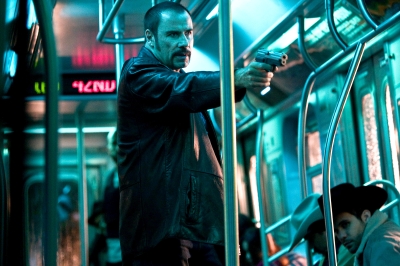The Taking of Pelham 123: Banana Milk Shake Recipe
Year Released: 2009
Directed by: Tony Scott
Starring: Denzel Washington, John Travolta, James Gandolfini, John Turturro, Luis Guzman
(R, 106 min.)

"There is a fine line between genius and insanity." Oscar Levant
The perfect popcorn thriller – an amiable bureaucrat trying to talk down a maniacal villain, 19 hostages sweating it out in an underground subway, a runaway train, cop cars exploding everywhere, and if that’s not sufficient combustion for you, there are enough F-Bombs to detonate all of Manhattan.
This film is a remake of the 1974 cult classic starring Walter Matthau and Robert Shaw. This critic has the distinct advantage of never having seen that film, so this review will be free of the usual quibbling disappointments that have colored the reviews of those enamored with its predecessor. Taken on it own merits, the film is fairly decent with some unexpected character development as well as the rather outmoded and juvenile use of that particular profanity already alluded to.
Luckily for us, Walter Garber (Denzel Washington) our affable but flawed subway dispatcher, is one of the few whose speech is not peppered with the distracting expletive, and his performance as an ordinary man in extraordinary circumstances, is flawless. It anchors the thriller and gives it a credibility that withstands unlikely airborne vehicles and the improbable gathering of ten million dollars cash neatly distributed in roller suitcases at the shake of a hat, or more precisely, a semiautomatic. This from a city that has enough on its hands just picking up the trash on time.
Part of the intrigue of the film is the gradual unveiling of the two leads with background and texture not part of the 1974 classic. Walter Garber seems a lackluster civil servant, competent as far as tracking his trains on a surprisingly sophisticated computer grid, but a man without any heroic tendencies or special insights into hostage negotiation. Oh, he does pick up on a few interesting strands, such as a hunch that the hostage taker is Catholic, but his hunches don’t seem to hold much with his superior, who can’t wait to usher Garber out the door. With little or no protest, Garber turns over his post to the expert, Camonetti (John Turturro) and is on his way home when summoned back at all speed.
It seems that Ryder (John Travolta), as the criminal mastermind calls himself, has taken a shine to the even keeled dispatcher and refuses to deal with anyone else. Little by little we learn why Garber and his hunches are so easily dismissed by his superiors. He is being investigated for charges of bribery, and his position as dispatcher is a temporary humiliation until he is cleared or convicted. His usual haunt is the glassed in office above.
Travolta’s Ryder is frenetic, over the top, and unhinged at times, but his character has an analytical brilliance as well as a few philosophical insights that raise him about the sum of his actions. He knows exactly the amount allotted to the city for emergency cash withdrawals and sets his demand to match. And when Garber pleads for the “innocent “ hostages, Ryder returns, “None of us is innocent, man.”
He looks death in the eye, too. “Dead is an improvement on a lot of things I can think of,” he taunts, or the almost Zen, “We all owe God a death.”
Director Tony Scott sets the frenetic pace with the opening sequence of a vibrant New York. The fast forward frames launch us into a warp drive tour of the city, setting up the importance of time and its swiftness, a measure Ryder later uses to ratchet up his control and menace. He wants his demands met in exactly one hour and will kill one hostage per minute thereafter. Almost as punitive as a late pickup at daycare.
Certain peripheral characters are especially effective, even if their time in front of the cameras is minimal. James Gandolfini plays hizhonor, the mayor, gruff, ready to retire, loving and hating the pull of the press and cameras, and beset with the usual political baggage, a messy divorce. “Was she worth it?” a reporter quips. “Yes,” the blunt answer we get only from one already exiting the political scene.
Hostage negotiator Camonetti, dubbed “Greaseball” by a disparaging Ryder who is loath to deal with well-rehearsed professionals, accepts his diminished role with the same equanimity Gerber does the sudden burden of his. He coaches from the sidelines, holding up improvised flash card tutorials, such as “Keep distracting him.” The main duty, he explains to Garber in between high voltage calls from their adversary, is to make Ryder forget the time, to walk him past it. This advice is critically important, especially when a spectacular crash delays delivery of the promised cash, and they must plead for time.
Luis Guzman plays a motorman gone bad, the insider who supplies the grit of technical knowhow to Ryder. With his almost thuggish face, the separated teeth and bulldog body, he is at once the working stiff and the ex-con, a guy who belongs in hell’s kitchen rather than Rodeo Drive.
Two would-be teen lovers figure in the plot also, via a computer connection that ends up operating as a spy cam for the authorities. Their relationship is clichéd and tawdry; she strips for him in front of her video camera, and it is only the lost underground connection that spares this full screen version of sexting. Later, when things are especially dicey, they declare their undying affection: “I F---king love you,” they each recite in their own defining deviancy down version of Romeo and Juliet.
Okay, Shakespeare it is not. But as a bit of film fluff, it meets the mark.
—Kathy Borich
Film-Loving Foodie
One of the scenes from the trailer is a quick phone call between subway dispatcher Walter Garber and his wife. He tells her that he is the one who will have to bring the cash to the crazed hostage taker huddled in the bowels of New York. In the teaser her whiny request that he bring a gallon of milk home after he finishes that assignment makes her the epitome of the nagging wife.
In the larger context of the film, however, I understand her inane request to be a kind of assurance that he will come out of this alive. After all, you don’t ask bullet-riddled bodies to stop off at the grocery store.
For this week’s recipe, I am selecting something to make with that milk, that great liquid white hope of continued existence. Even though it is barely spring, this smooth and creamy Banana Milk Shake will help you anticipate sunny days ahead.
Banana Milk Shake
- 2 lg. bananas
- 5 c. cold milk
- 1/2 c. whipped cream or vanilla ice cream
Mash bananas in mixing bowl with fork, add milk, stirring until blended. (May also use blender.) Pour banana mixture into tall, chilled glasses and top with a spoonful of whipped cream or ice cream.
Recipe Source: Cooks.com



 Classic & Crime
Classic & Crime